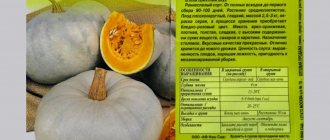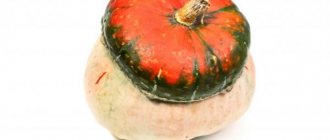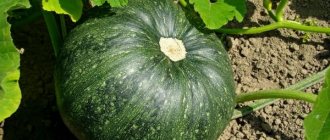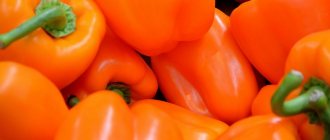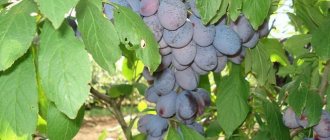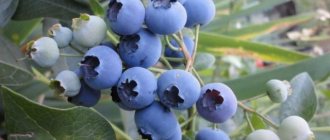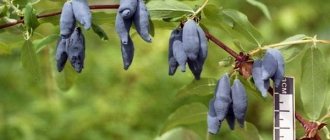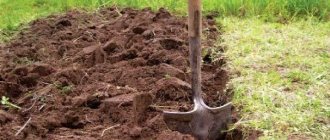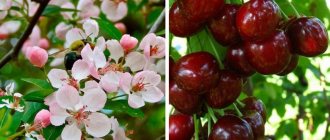Description
The name Honey is common to several varieties that differ in external characteristics, but are similar in taste. The varieties are mainly mid-season: ripening occurs no earlier than 110 days. The plants are unpretentious in care, resistant to changes in temperature, and can withstand slight cold snaps. They have long lashes that grow more than 1 m.
Pumpkin is grown in any climate zone. Depending on the region, the planting method changes: the vegetable is sown directly into the ground only in the southern regions; in colder climates, seedlings are grown.
The varieties have increased immunity to common diseases and pests.
Distinctive features
The seed bank remains viable for several years, so it is not necessary to plant seeds collected last year. Any soil composition except clay soil is suitable for growing vegetables. In such soil it will not be possible to get a rich harvest.
Fruit characteristics
Depending on the variety, honey pumpkins vary in weight and shape. Basically, ripe vegetables have an orange color and pulp of the same color. Average weight - 2–5 kg, rounded-flattened shape. The taste is sugary, the flesh is juicy and tender. The peel is thin, but reliably protects vegetables from damage.
The photo shows one of the varieties of honey pumpkins.
Productivity
The yield of such varieties is high: the average is 10–15 kg per 1 m2. Productivity is influenced by climatic features and soil composition. In light fertile soil the indicator is highest.
The best pumpkin varieties for the Moscow region and central Russia
The Moscow region and central Russia are suitable for growing all types of pumpkins, but there are varieties that in this region are characterized by high yields.
Healing
The Healing pumpkin variety is distinguished by early harvest and good winter hardiness, valued for its pleasant aroma, taste and color. A special advantage is the early ripening of the fruit and a long storage period (six months). Pumpkin has a specific shape and a beautiful pattern on the skin. Thanks to its juicy pulp, it is ideal for making juices and purees.
It is grown in open ground by seedlings. Seedlings are sown in cups in April, and at the end of May they are transferred to the soil. If the thermal regime is maintained at 20-25 degrees, seedlings appear on the eighth day. Before planting in the soil, it is necessary to harden the seedlings, gradually accustoming the plants to the open air.
It is recommended to sow seeds in the soil in June, when the earth has warmed up and there is no return of frost. The plant requires light, prefers unthickened plantings and responds well to fertilization.
Gribovskaya
Gribovskaya
The Gribovskaya pumpkin variety has long been loved by gardeners and gardeners. It is ideal for processing and long-term storage. The level of sugar and solids in pumpkin increases with optimal storage time. The taste properties of pumpkin are preserved until the new harvest. It is intended for dietary and baby food.
Gribovskaya has long vines, which allows you to reap a rich harvest. The fruits are large in size (4-8 kg), smooth milky skin and bright orange pulp. They are excellent at transporting over long distances.
Gribovskaya bush 189
Gribovskaya bush 189
It has light orange, egg-shaped fruits. Ripe pumpkins are decorated with wavy green patterns and have a sweet taste and delicate aroma.
Seeds of “Gribovskaya bush 189” are sown directly in open ground at the end of May.
Dacha
Dacha
Belongs to very early varieties. The plant bears fruit 70 days after the first shoots appear. They are oval in shape and have a sweet taste. The weight of the fruit ranges from 2 to 4 kilograms. The main advantage is high yield and cold resistance. To obtain optimal results, seeds are sown in the soil after the ground has warmed to a temperature of 12-15 degrees. The plant requires regular watering and loosening of the soil.
How to grow
Pumpkin is grown through seedlings or by directly planting seeds in the ground. The main thing in both methods of breeding is the correct choice of soil and site. Pumpkin grows well in fertile soil on the sunny side.
Planting by seeds
Residents of the southern regions cultivate vegetables not only by seedlings, but also by direct sowing in the ground. Planting is carried out in late April - early May, when the soil warms up to +12...+14°C.
The seed material is first disinfected in a weak solution of potassium permanganate for 20 minutes.
Place 3 seeds in a damp hole 5-6 cm deep in different corners. Sprinkle the top with soil and cover with film until shoots appear. The distance between the holes is 70–90 cm. With a higher frequency of planting, plant vines will interfere with each other’s development. As soon as the shoots appear, the film is removed.
No more than 2 sprouts are left in one hole. If all 3 seeds have sprouted, choose those that are stronger and pinch off the rest.
Reference. In heavy soil, seeds are planted to a depth of 3-4 cm so that they germinate.
Sowing seedlings
They begin to grow seedlings 1 month before transplanting into the ground. Light and fertile soil is purchased at a specialized store. If the soil is prepared independently, it is spilled with a solution of potassium permanganate for disinfection. Prepare the soil from garden soil, peat and river sand in equal proportions.
Individual containers for planting are used, with a volume of at least 0.5 liters. Small drainage holes are made at the bottom to drain excess moisture. Lay out some sawdust and fill the container 2/3 full with soil mixture.
Reference. Seedlings do not tolerate picking well and can die at the slightest disturbance of the root system. Therefore, the seeds are planted immediately in individual containers.
The grains are buried 5 cm, sprinkled with soil on top, slightly moistened, covered with film and left in a warm place until shoots emerge.
Seedling care
When the first shoots appear, the film is removed and the containers are placed on the windowsill, closer to the sun's rays. After 10 days, a full complex of minerals is added along with abundant watering. Moisten as needed with a shallow watering can. Loosen the soil after each watering with a wooden stick, superficially, without touching the young roots.
1 week before transplanting, the seedlings are fertilized again with a full range of minerals.
After the last feeding, young plants are hardened by taking them out into the open air during the day for several hours. This helps the crop quickly adapt to street conditions.
Transplantation into the ground
Planting pattern:
- distance between holes - 70–100 cm;
- row spacing - 80 cm.
The soil is prepared 2 weeks before planting: it is dug up and humus is added.
Transplant the sprouts into the holes together with an old clod of earth, otherwise the seedlings will not begin to grow for a long time. The optimal time for transplanting is late in the evening or early in the morning, so as not to burn the young plants.
The beds are chosen on the sunny side, but the seedlings are not planted under the scorching rays of the sun. After transplanting, the holes are watered and left for several days for the plants to adapt to new conditions.
Further care
An unpretentious plant does not require complex care. For the full development of seedlings, regular watering and timely application of fertilizing are sufficient.
Watering
Water the crop abundantly and regularly until flowering . During this period, the soil is not allowed to dry out. As soon as the plants bloom, reduce the amount of watering. Moisten the soil as the top layer dries out. After the fruits ripen, irrigation is stopped.
For rapid pumpkin growth, the ground is periodically loosened, especially after watering. Loose soil promotes better penetration of oxygen and nutrients to the roots.
As weeds grow, the beds are weeded. The grass is removed with its roots, as they take a lot of useful substances from the ground and interfere with the development of cultivated plants.
Feeding
As a fertilizer, mullein infusion is used in a ratio of 1 liter to 1 bucket of water. The first time they are fed 10 days after transplanting into the ground. The product is poured strictly at the root along with abundant watering.
The second time the pumpkin is fertilized during the initial flowering period. The procedure is repeated after 1.5–2 weeks.
The following feedings are carried out at intervals of 2 times a month.
Formation
Pinching the vines allows you to get large fruits. If the number of ovaries is not regulated, the vegetables will grow small.
No more than 4 ovaries are left on the shoot, the rest is pinched, thereby stopping the growth of the lash and the formation of new fruits. In this case, all nutrients will be spent on existing ovaries.
To stop the growth of lashes, the part that comes off after the 5th leaf is sprinkled with earth.
Reference . The colder the cultivation region, the fewer ovaries are left on the shoot.
Difficulties in growing
During the growing season of the crop, a net or supports are installed along which the plants will send lashes. On wet soil they rot and cause the spread of fungal infection.
For the full development of 2 seedlings growing from one hole, the shoots are directed in opposite directions.
Advice from experienced gardeners
Recommendations from experienced vegetable growers will help you get a harvest with minimal losses:
- When planting seeds directly in the ground, after sprouts appear, they are covered with caps. This creates a greenhouse effect for the rapid growth of the pumpkin in the future. This shelter protects the seedlings from precipitation.
- Compost is spread around the planting hole. It enriches the soil with useful substances necessary for rapid seed germination.
Diseases and pests
Varieties of honey pumpkins are resistant to pathogens of fungal and viral diseases, but in wet weather they are affected by rot. Therefore, in rainy summers, pumpkins are grown on hills and small hills. Aloe juice helps with rotting. They treat bushes with it, cutting out rotten parts.
Among the pests that are dangerous for pumpkin are aphids and wireworms. To remove wireworms, the soil is dug deep, and against aphids, the plants are treated with a decoction of wormwood.
Features of care
An unpretentious plant to care for, it requires compliance with the minimum rules for caring for garden crops.
Watering and fertilizing
Abundant watering is carried out mainly before flowering. Enough water is poured out so that the soil is constantly wet. With the appearance of the first color, the frequency of irrigation is reduced. Now the soil under the bush must dry out before it is irrigated next time. When the fruits complete their ripening, watering stops.
There is no need to be fancy with fertilizing. Honey pumpkin varieties respond well to a simple nutritious mixture of water and mullein (1 liter per bucket of water). The first feeding is done seven days from the moment the first leaves appear.
The next time they fertilize is when the pumpkin begins to bloom, and again after ten days. The remaining feedings are carried out twice or thrice a month. Fertilizers need to be applied at the root.
Weeding and loosening the soil
Until the pumpkin begins to spread along the ground, covering it with its foliage, the ground needs to be loosened after each watering. Row spacing also requires regular loosening. Weeds are removed as needed.
Bush formation
On long-climbing bushes, a lot of ovary is formed. But if its quantity is not regulated, the fruit will grow small, therefore, in order to get a full-fledged vegetable, up to 3-4 ovaries should be left on the shoot.
Learn how to properly form a pumpkin in open ground.
To prevent new fruits from forming above existing ones, the shoot behind the fifth leaf is pinched.
Those shoots without an ovary are removed completely.
Important! The number of fruits left on the bush depends on the region. The further north it is, the fewer fruits will have time to ripen.
Diseases and pests
All honey pumpkin varieties are resistant to popular diseases and pests. But as a preventative measure, during plant growth it must be treated with fungicides according to the instructions on the packaging.
Harvest and storage times
If the seeds are planted in May and the pumpkins ripen for 3–4 months, then harvesting can be done in August-September. The fruit is picked ripe along with the stalk. It helps extend shelf life.
The ideal storage temperature for pumpkin is +5...+15 °C. The room where the crop is stored must have good ventilation. Under such conditions, honey pumpkin can last for 5–7 months.
Harvesting and application
is harvested in August – September. Vegetables must be cut with the stem removed to increase shelf life.
The harvest is placed in a well-ventilated room with a temperature of +5…+15°C. In such conditions, the fruits retain their quality for up to 7 months.
Ripe vegetables last in the refrigerator for about a month, and in the freezer - up to 1 year. Before freezing, they are cut into pieces.
The use of pumpkin is universal: it is suitable for baking, cooking porridge, and frying. Juice is made from the pulp, and it is also consumed raw. Honey pumpkin is used for drying and drying.
Dessert pumpkin variety Honey Princess//Secrets of good harvests.
Protection from diseases and pests
Diseases:
- powdery mildew;
- rotten.
The first problem will require deep plowing and abundant watering.
Aloe helps against rotting. It is necessary to cut out the bad tissue and treat it with agave juice. Everything heals, the plant will continue to grow safely.
Pests
It will help against wireworms:
- plowing;
- liming of acidic soil;
- bait in the form of pieces of beets;
- spraying with insecticides.
Helps against aphids:
- getting rid of weeds;
- spraying with a decoction of wormwood with washing soap.
Varieties of honey pumpkins
There are many varieties of this pumpkin, each of which has its own characteristics.
Orange F1
Full maturation of the hybrid occurs after 120 days. The skin color is dark orange with pronounced gray stripes along the ribs. The length of the lashes reaches just over 1 m. The weight of ripe fruits is 2–3.7 kg. The pulp is reddish-orange sugary. The vegetable is versatile in cooking.
Dessert
The variety has large round fruits, slightly flattened on both sides. The color is dark pink. The ribbing is strongly pronounced. The pulp is juicy orange-colored. Weight of vegetables - 3.5–5.8 kg. The variety is early ripening - ripens in 90 days.
Guitar
The variety differs from other varieties in its unusual shape, reminiscent of a guitar. Fruit length is 60–70 cm, diameter is 11–13 cm. The peel is thin and light. The pulp is deep orange and takes up 90% of the entire vegetable. Pumpkin is often consumed raw because of its tenderness and sweetness. The variety is mid-season - the fruits ripen in 110–120 days.
Princess
The color of the skin of this pumpkin is faint orange, dull, and the shape is rounded and flattened. The pulp is bright orange, sweet, contains a lot of sugar and carotene, and is therefore suitable for baby and dietary food. Fruit weight is 3-4 kg. The variety is mid-season: the growing season is 115–120 days.
Fairy tale
Pumpkin Honey Tale is very similar in appearance to Dessert: it has the same bright orange color and pronounced ribbing. Weight does not exceed 4 kg. The pulp is the sweetest of all. Full ripening occurs 120 days after planting.
Chit
The latest variety: the fruits ripen no earlier than 120–128 days. Vegetables are almost the same size, average weight is 3 kg. The shape is round, the color of the peel is ashen with pale pink spots. The ribbing is weakly expressed. The pulp is rich yellow. Pumpkin is versatile in cooking. The variety Honey crumb is bushy, not climbing.
Recommendations for growing pumpkins
Even an inexperienced gardener can grow a pumpkin crop. But it’s still better to study the plant’s “requirements” for care in advance.
Watering
Thanks to its developed root system, pumpkin tolerates drought well, but nevertheless needs frequent and abundant watering. The fact that the time has come for the next irrigation can be judged by drooping leaves that have lost their tone.
In the first week, pumpkin seedlings transplanted into the garden bed are watered every day. As soon as it begins to grow, moisture is reduced to the required minimum until fruit ovaries the size of a child’s fist are formed. After this, watering is resumed, starting with 3–5 liters per plant and gradually increasing the rate to 10–12 liters.
Pumpkin is a moisture-loving crop; both seedlings and plants need regular watering during fruit ripening
The water must be warm. This stimulates the formation of more female flowers. Cold weather can trigger the development of root rot.
Then it is advisable to loosen the soil well to a depth of about 10 cm. At the same time, add soil to the base of the vines, giving the plants a certain stability.
Top dressing
When it comes to feeding, pumpkin prefers natural organic matter. You need to be very careful with nitrogen fertilizers - their excess stimulates the plant to actively form green mass to the detriment of the fruits, increases the content of nitrates in the pulp and reduces its sugar content.
The pumpkin is fertilized for the first time 7–10 days after planting in the ground. Then continue feeding at the same interval. Plants are watered with an infusion of fresh cow manure, bird droppings, nettle or dandelion leaves. Before use, it is filtered, diluted with water, and 10–15 g of simple superphosphate and potassium sulfate are added. The fertilizer is poured into ring grooves with a diameter of 40–50 cm, then they are covered with earth again. For variety, you can use an infusion of wood ash.
Pumpkin loves nettle infusion, like any other organic fertilizer.
Formation
When the stem reaches 1 m in length, the top of the plant is pinched, stimulating the development of lateral shoots. As the vines grow, remove the “stepchildren” (axillary shoots) as soon as they reach 5–7 cm.
As they grow, it is advisable to direct the emerging lashes to the south, pinning them to the ground in the desired position with pieces of wire. On each of them, no more than two or three ovaries are left (for especially large-fruited varieties - one) and the excess leaves that cover it from the sun are cut off. A piece of plywood, glass, or roofing felt is placed under each fruit to protect it from rotting and other fungal diseases.
Video: pinching pumpkin vines
Pollination
Pollination of a pumpkin, especially if it grows in a greenhouse or under covering material, is best done independently. There is no particular hope for insects even when the summer is cool and rainy. To do this, you need to pick 2-3 male flowers (they can be easily identified by the absence of an ovary), tear off the petals and run the anthers several times over the stigmas of the female flowers. The best time for the procedure is not too early in the morning (09:00–10:00) on a warm, windless day.
Pumpkin pollination is best done manually and over several days in a row.
Typical mistakes of a novice gardener
Often the gardener himself is to blame for the lack of harvest. The most common mistakes:
- The largest seeds are used for planting. Powerful lashes grow from them, but fruits set very reluctantly. Seeds are selected based on their weight - the heavier the better;
- dense plantings. Pumpkin, which has a powerful root system, needs sufficient area for nutrition. The required minimum is 3 m².
- seed planting depth. The colder the region, the less you need to bury the seeds, especially in a rainy spring;
- choosing a landing site. Often, in order to save space on the site, pumpkins are planted under fruit trees. In this case, there will be enough light for it, but the much-needed frequent and abundant watering can lead to the death of the tree due to rotting of the roots;
- planting on a compost heap. This method is quite justified in the Urals and Siberia, where there is often not enough heat in the summer. But you need to take into account that the flesh of these pumpkins will be loose and not particularly sweet. And they are no different in keeping quality.
https://youtube.com/watch?v=vfydpVjdhBI
Farmer reviews
Positive reviews from gardeners complement the list of benefits of honey pumpkins:
Ekaterina, Ufa: “I have been growing honey pumpkins for 3 years because of their juiciness and tender pulp. Caring for vegetables is easy, and the harvest is always pleasing. The only thing is that I always sprinkle the vines with earth when they grow more than 1 m. This way, new fruits do not form on them, and those that already exist grow larger. I like baked pumpkin best.”
Stanislav, Saratov region: “I love pumpkin in different dishes. I plant many varieties myself, including honey varieties. I like their taste, tender, juicy and sugary. Plants do not get sick and do not require much attention throughout the season. I make different dishes from ripe vegetables, but my favorite is porridge.”
